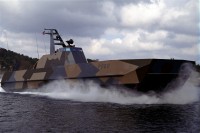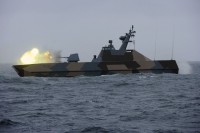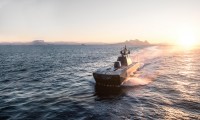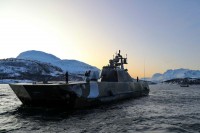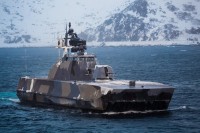Ракетные катера типа «Скьёльд»
Основная информация
Главные размерения
Машина
- 2 * Pratt & Whitney ST40M gas turbines
- 2 * Pratt & Whitney ST18M plus gas turbines
Персонал
Боевые силы и средства
- Thales MRR-3D-NG air/surface radar
- Saab Ceros 200 FC
- CS-3701 electronic warfare suite
- Sagem Vigy 20 electro-optical sensor
- Soft kill:
- TKWA/MASS (Multi Ammunition Softkill System)
- Other: Link 11 and Link 16
- 8 * Kongsberg Naval Strike Missile SSMs, kept in an internal weapons bay
- 1 * 76mm Otobreda Super Rapid multi-role cannon
- 2 * 12.7mm Browning M2HB HMGs
- Mistral SAMs
- Protector (RWS) (Sea Protector)
Skjold-class corvettes (skjold means «shield» in Norwegian) are a class of six large, superfast, stealth missile corvettes in service with the Royal Norwegian Navy. The boats were formerly classed as MTBs (motor torpedo boats) but, from 2009, the Royal Norwegian Navy has described them as corvettes (korvett) because their seaworthiness is seen as comparable to corvettes, and because they do not carry torpedoes. They were built at the Umoe Mandal yard. With a maximum speed of 60 knots (110 km/h), the Skjold-class corvettes were the fastest combat ships afloat at the time of their introduction.
The Skjold-class vessels began with the development of the Royal Norwegian Navy's «Project SMP 6081», and the first preproduction version was ordered on 30 August 1996. The first ship of its class, P960, was launched on 22 September 1998 and commissioned 17 April 1999. A Norwegian Parliamentary White Paper of 2001 recommended building five additional boats, and this was agreed to in 2002. Six Skjold-class vessels replaced the Royal Norwegian Navy's previous fourteen Hauk-class patrol boats.
The Skjold design is a surface effect craft, constructed of glass fibre/carbon composite materials. Buoyancy is augmented underway by a fan-blown skirted compartment between the two rigid catamaran-type hulls. This provides an alternative solution to the planing hull/vee hull compromise: the air cushion reduces wave slam at high speeds while presenting a low-drag flat planing profile at the waterline.
To ensure stealth capabilities, anechoic coatings of radar absorbent materials (RAM) have been used in the load-bearing structures over large areas of the ship. This strategy leads to significant weight saving compared to the conventional construction technique of applying RAM cladding to the external surfaces. The ship's profile has a faceted appearance with no right angle structures and few orientations of reflective panels. Doors and hatches are flush with the surfaces and the windows are flush without visible coaming (edge of window aperture) and are fitted with radar reflective screens. The vessels are additionally protected by the Rheinmetall MASS sensor / decoy system.
The final design was changed compared to the prototype Skjold, which itself was rebuilt to the new specifications. Most notably, the vessels use 4 gas turbines combined by Renk COGAG gear units built in a lightweight design. The smaller gas turbines rated 2,000 kW turbines are used for cruising speed. For sprint speed a second, larger gas turbine is combined providing a total of 6,000 kW to the waterjet on each shaft line. Two MTU 123 cruise diesel propulsion units used previously at loiter speeds were removed. The foredeck was strengthened to accommodate the addition of a 76 mm Otobreda Super Rapid gun.
The hull material was produced by a different method to improve strength and minimize vulnerability to fire. The bridge saw some changes, including an upgrade to six weapon systems control consoles.
Корабли6
- Комментарии
 ru
ru en
en uk
uk
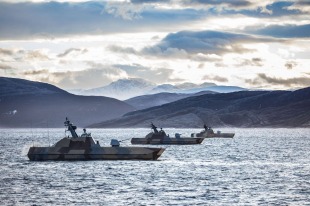



 Королевские военно-морские силы Норвегии
Королевские военно-морские силы Норвегии Umoe Mandal AS
Umoe Mandal AS